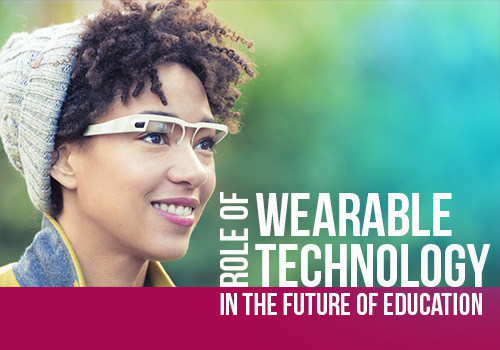Categories(658 Blogs)
Select Category
Watch Right Now
Teacher App - Class
Schedule & Attendance Management App
Parent App from Edsys

Best School Bus Tracking System

Cashless School - For Smart Schools of Tomorrow


Role of Wearable Technology in the Future of Education

“We need technology in every classroom and in every student and teacher’s hand, because it is the pen and paper of our time, and it is the lens through which we experience much of our world.” – David Warlick
LED TVs, smarter mobiles, tablets etc. are all now few among our everyday things, right? The latest in trend is the use of wearable technologies. Not only business, retail, entertainment or health, even schools and other educational institutions can take advantage of these wearables. Wearable Technology in education plays a key role in taking this community to the next level. According to a market report by Research Moz, global classroom wearables technology market is estimated to grow at a CAGR of 36.57% during the period 2016-2020. Key vendors operating in this market include Apple, Google, Microsoft, and Samsung.
Read Also:
While improved student engagement is a key factor that drives the market, lack of data privacy and security is expected to be the market challenge during the forecast period. These wearable technologies can-
- Improve student engagement in education
- Increase the level and quality of teacher-students communication
Check out few wearable technologies and how they are helpful in the classroom.
This advanced technology is ideal to help students as well as teachers to make the learning process smoother and engaging.
Students can use the glass to –
- take notes
- bookmark important passages
- view extra-classroom content provided by the lecturing professor
- get a virtual reality experience of events on the athletic field, or in outer space
Foreign students can benefit from real-time language translation and prospective students can tour the campus via a live Hangout. With Google Glass, students with visual, auditory and physical disabilities can even get better accessibility to their learning materials.
Teachers can create schedules and share them with their students. The facial application feature of the Glass helps educators to identify any number of students they teach. They can also learn programs that meet the students’ requirements. The Glass features an Augmented Reality Feedback System that helps to identify students who are getting weak in their studies. By recognizing their strengths and weaknesses, teachers can teach them accordingly. To enhance teaching, mini-documentaries can also be created. Real-time referencing and ability to send messages including progress reports to parents also make this platform an advanced for the teaching community.
It has been proven that iPod technologies provide great opportunities for students with flexible learning. This effective learning tool allows students to think more creatively about their subject matter and encourage the development of collaborative learning. Hence, it gives a sense of self-empowerment and autonomy to the individual.
You May Also Like:
Smart Watches and wearables have been an amazing inventions for the modern business person. With innovative education apps, smartwatches can help students to –
- Learn foreign language
- Play interesting games
- Enhance their memory capacity
The app even allows tracking fitness at an early age. Students can keep track of their total steps, calorie burn and even their heart rate during a game.
This high definition small personal camera serves as a great platform for students to research and explore. Easy to mount anywhere or worn, students can use this camera to take pictures during their class for presentations and projects. This device is an excellent choice for the classroom. However, it is recommended that your GoPro be up-to-date with the latest features and best performance. This camera even assists to capture a teacher’s point of view of events, such as a lesson or student behavior.
A 2016 report by Research and Markets predicts that the adoption of wearable technology in schools will grow by 46% per year over the next five years. Choose wearable technology in education to enhance learning outcomes in students in order to access education flexibly, calmly and seamlessly.
Recent Blogs
Our Educational Services
Popular Blogs
Subscribe

SUBSCRIBE TO OUR NEWSLETTER
Sign Up and Recieve the Latest News
Don’t Worry, We Don’t SpamExplore Our Extensive Researched Educational App Directory
Visit Now














